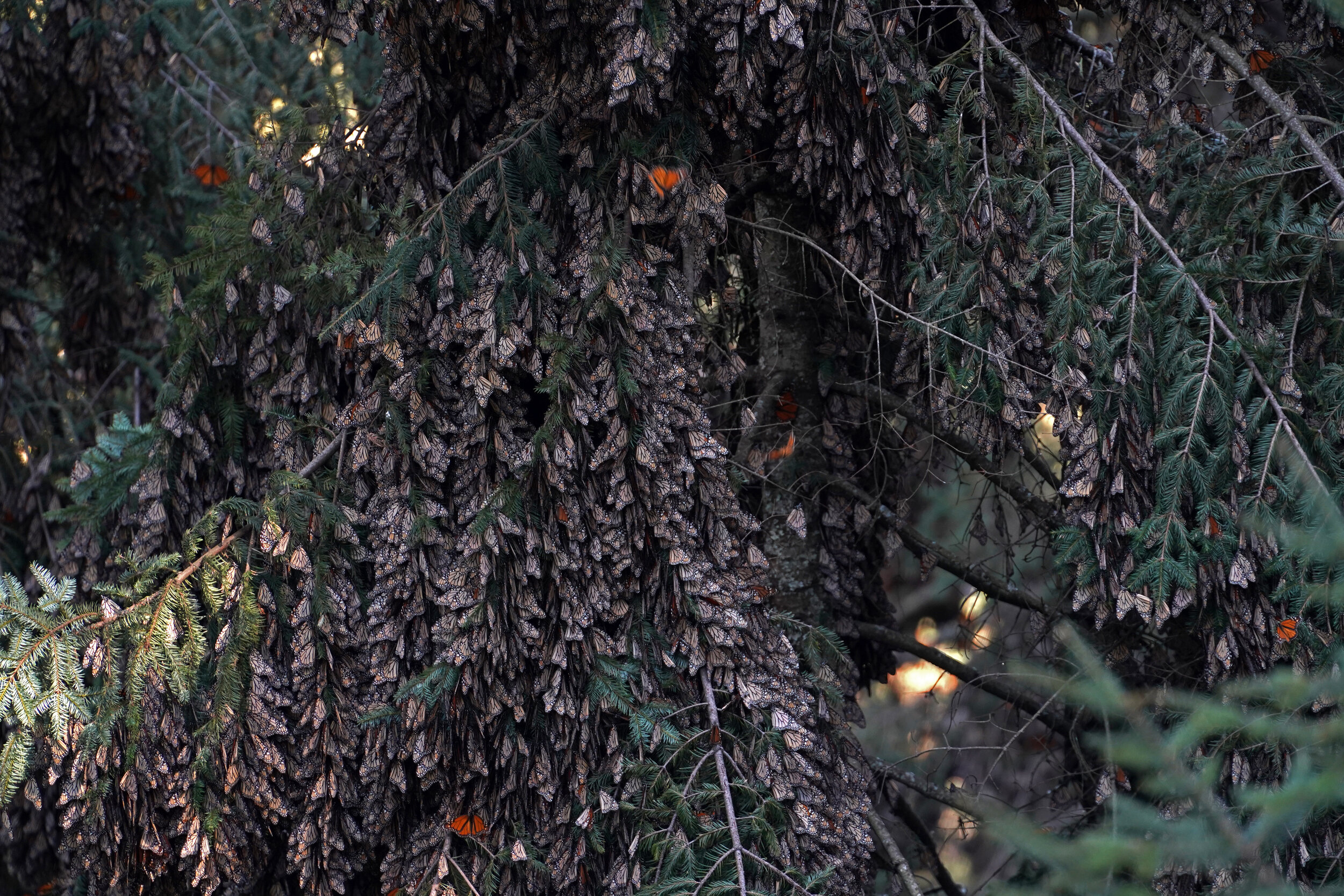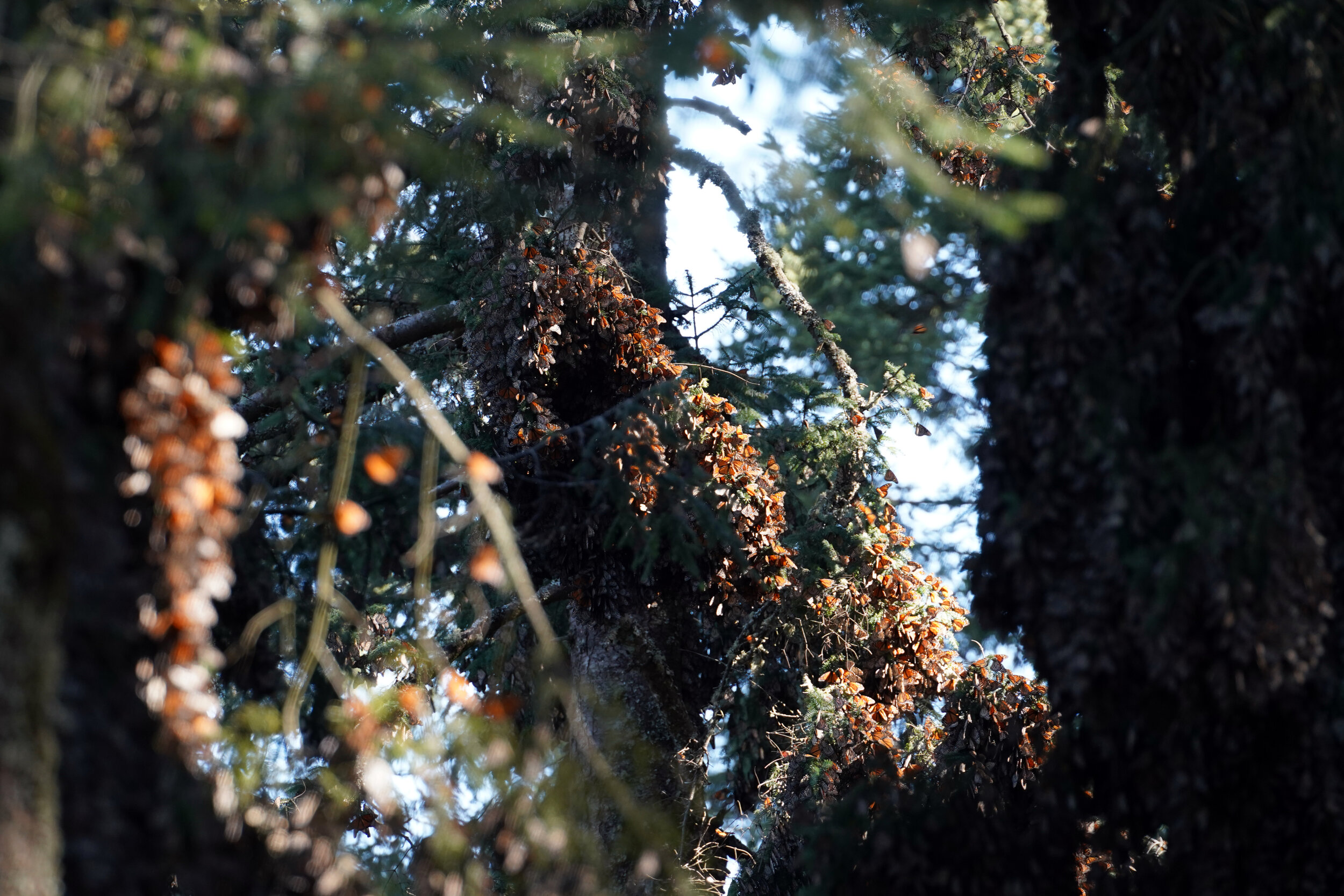
LIVES CUT SHORTER: HOW MONARCH BUTTERFLIES ARE AT RISK
Written by: Robyn Huang.
Photos by Matt Reichel.
Trees of Butterflies
Michoacán, Mexico. February 2021.
Butterflies congregate together on fir trees during the night and into the morning, as temperatures drop and the butterflies huddle for warmth and protection. They form structures on tree branches and trunks so thick that they look like leaves.
MICHOACÁN, MEXICO.
As the early morning sunlight peaks into tall, looming treetops, a mesmerizing scene begins to unfold high in the quiet, ethereal mountain forests of Central Mexico. Atop many tree branches along this forest belt are dark brown clusters, almost leafy looking in appearance.
The forest awakens as sunbeams hit every branch, and the optical illusion of leaf clusters knowingly flips a switch. Floating orange spots emerge from these clusters, slowly but whimsically navigating across the forest and gradually multiplying in volume. As the sun intensifies, this vibrant visual becomes clearer.
The dark clusters ripple into graceful swarms of vivid orange monarch butterflies, crowding the highest and warmest treetops for sunlight warmth and, most importantly, amidst an already short life -- to stay alive.

Butterfly Congregation Up-close
Michoacán, Mexico. February 2021.
Butterflies congregate together on fir trees during the night and into the morning, as temperatures drop and the butterflies huddle for warmth and protection.
Every fall, from November until the beginning of March, millions of monarch butterflies migrate almost 3,000 miles for survival, travelling from northeastern Canada and the U.S. and descending upon higher altitude areas of Central Mexico.
They leave North America in the late summer, flying for almost two months. This journey is the most advanced migration of any known insect. These intelligent creatures will instinctively know when it is the right time to leave and roughly where to go using only environmental cues.
The butterflies settle and roost by the millions on branches of oyamel fir trees, which grow at altitudes of over 3,000 metres. They begin take flight as soon as the sun emerges and then huddle together in the oyamel-firs at night. The cool mountain climates, ranging from zero to 15 degrees Celsius, slow their metabolism, allowing them to save their energy. The humidity in these forest ecosystems also ensures the monarchs have access to water and will not dry out.
Their wintering area, known as the Monarch Butterfly Biosphere Reserve, spans a 139,000-acre area, straddling Mexico and Michoacán states. This reserve is a partnership between the Mexican government and the World Wildlife Fund. The survival of the species depends on many habitats across Mexico, Canada and the U.S. during its full annual migration cycle.

Tree Full of Light
Michoacán, Mexico. February 2021.
Monarch butterflies gather on a tree basked in early morning light. As the butterflies need sunlight to warm their blood, they are attracted to trees covered in sun rays in the cold mountain mornings.
Monarch butterflies usually live only three to four months. Their breeding generation referred to as a “Methuselah” generation, is unique. This generation survives sometimes greater than nine months to survive the journey to Mexico, breed and then make the return journey back to North America. Monarchs are the only butterfly known to make a two-way migration.
Once the butterflies arrive, citizen scientists and naturalists will conduct a census on how many have completed the journey. Researchers have documented annual declining numbers. Studies have shown a population decrease of 53 per cent from the previous season.
Research investigations have also suggested several factors contributing to their decline, including climate change, pesticide usage, and illegal deforestation. The root causes of these factors are not specific to Mexico, Canada or the U.S
Colder temperatures and flash freezes limit a butterfly’s survival. Texas, the first main stop on their journey north and where they start laying eggs, saw its coldest recorded temperatures this year. Many breeding generation butterflies die before even leaving the United States or Canada.
In conjunction with U.S. large scale use of herbicides, colder temperatures also limit the growth of milkweed plant. Milkweed is where they lay their eggs and is the primary food source for monarch caterpillars. Limited milkweed has resulted in lower numbers of caterpillars, contributing to smaller future generations.
The U.S. Fish and Wildlife Service estimates that saving eastern monarch populations will require roughly 1.8 billion milkweed plants, which has resulted in many call-to-action milkweed planting campaigns by ecologists.

Dancing Fairies of the Forest
Michoacán, Mexico. February 2021.
Monarch butterflies fluter between flowers and bushes in the Michoacan forest in the late afternoon.
In Mexico, the WWF monitors the reserve’s forest coverage annually. Reforestation efforts have occurred. Since 2005, 37,000 acres have been replanted. However, replanting takes time. According to the reserves, oyamel-fir trees can take up to 50 to 80 years to grow to the point that is sustainable for habitation. So, the conservation of overwintering habitats is crucial to butterfly survival, as the conditions provided by these forests match the monarchs’ breeding needs.
Conservation efforts are focussed on protecting both the butterflies and their forest habitats but can be complicated.
Communities in areas like Sierra Chincua, Cerro Pelon, and El Rosario are impoverished with scarce access to essential services. Their survival is dependent on subsistence farming and remittances. In the past, mining provided jobs, but these opportunities have since depleted.
As a result, some residents have been turning to illegal logging. Chopping down trees is a lucrative source of additional income for communities suffering extreme poverty. It also serves as a supply for local fuel needs and raw materials for handicrafts. A single tree is destructed to make wooden boxes for shipping fruit and pallets for construction.
The forests are supposed to be protected by the Federal Police or Gendarmerie, but corruption is rampant. Residents can cut down trees legally with a permit. By bribing off the police, illegal tree-cutters or talamontes can cut down more than what is allowed. A permit for 100 trees could end up in 500 trees being cut down.

Butterflies Dripping from the Trees
Michoacán, Mexico. February 2021.
A cluster of monarch butterflies is illuminated by early morning sun rays in the forests around El Rosario Reserve.
Mexico’s butterfly reserves are not public. They exist on lands belonging to farming and indigenous communities called ejidos. Ejidos are shared areas of communal land primarily used for agriculture and granted by the Mexican state.
The town of Angangueo sits at the centre of these reserves. The town’s economic livelihood depends on butterfly tourism. Ejido communities around Angangueo have been earning revenue from roughly up to 150,000 tourists each year, who participate in organized hikes to see the butterfly colonies. In a non-pandemic year, an ejidatario could earn over USD 1,000 in tips from tips and sharing in entrance tickets fees.
These communities are directly and indirectly employed in the tourism sector and are invested in protecting these forests to preserve this income stream. Ecotourism plays a crucial role in forest conservation by preserving these forests and generating income for locals.
“Butterflies are economically important for the community. About 50 percent of the people from my community work in connection to butterfly tourism,” says Mauricio Martinez Romero, a 14-year-old ejidatario working for the Sierra Chincua reserve.
Martinez has been working at the reserve annually since he was a child. He commutes two hours every day between his community and the reserve, accompanied by his grandmother who runs a food stall near the ticket office.

The Towns of Butterflies
Michoacán, Mexico. February 2021.
For the towns and ejidos located within and around the Monarch Butterfly Reserve in Mexico’s Michoacán and Estado de Mexico states, butterflies comprise their largest economic sector in the form of organized ecotourism. Between 100,000 and 150,000 people visit the reserves each year.
The survival of the butterflies and the communities that support them is intertwined. Butterflies put food on families’ tables.
These remote farming areas would not necessarily see visitors otherwise, and so the added income incentivizes locals to act as forest guardians and protect the butterflies within them.
Ejidatarios are quick to warn tourists to keep back from areas with high concentrations of butterflies and to watch out for butterflies who stop to take a break on a path. Tourists can trample butterflies by mistake and create disturbances through added sound and movement. All along hiking reserve trails are warning signs to keep quiet and not to touch the butterflies.
Community residents are not blind to the effects of illegal logging and how it could wipe out their economy and existence. The population has an incentive to protect the butterflies. If certain residents cut down the trees, this threatens both butterflies and communities.
“If we don’t do anything, the day will come when the butterflies no longer visit us due to the lack of forests and because they are scared away by the cutting of trees. If there are no forests, there is nothing. It will end for all of us who receive tourists and provide services,” explains Angangueo community resident and taxi driver Miguel.

Jumping between Trees
Michoacán, Mexico. February 2021.
Recently awake, these butterflies are jumping between tree branches as the morning sun begins to warm their bodies, bringing their forest colony to life.
If the butterflies do not survive, neither will the people who depend on them.
The truth of the matter is the monarch butterfly may very well be on a path to extinction. This path has been created through a confluence of factors dependent on proactivity to save the butterflies.
Whether it’s planting more milkweed, protecting forests from illegal logging, or keeping tourists at bay, guarding the next generations of monarchs requires intervention and efforts in Mexico and North America.
There’s no one reason why they’re in danger, and there’s no one best way to keep them and their migratory patterns alive. But, recognizing how important they are to nature and evolution and finding every possible way to protect them is a start.
